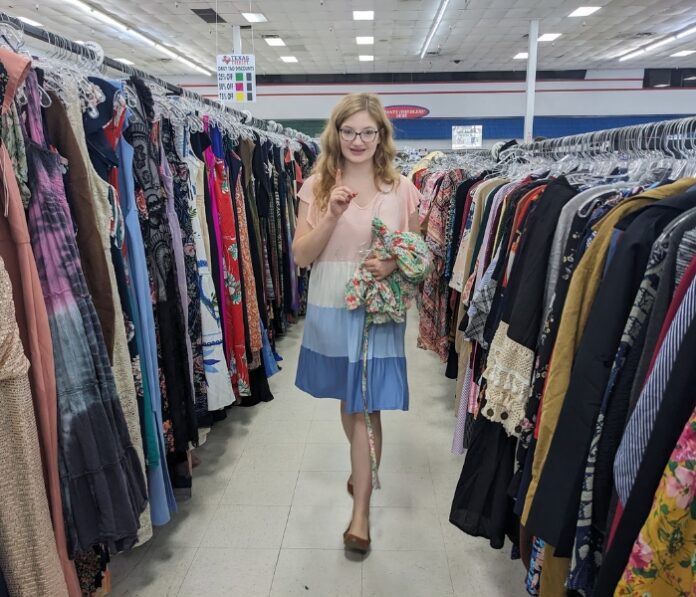Over the past few years, thrifting has become popular among consumers of all ages. It’s a great way to update your wardrobe, find unique pieces and save money, especially as a college student.
So, if you’re new to thrifting and looking for a guide to get started or simply looking for ways to up your thrifting game, here are some helpful suggestions for your next thrifting adventure.
- 1. Check the quality of the piece.
Thrift stores acquire their inventory in various ways. Some second-hand stores, like Texas Thrift or St. Vincent de Paul, rely on donations to keep their stores stocked, while others, like Plato’s Closet, obtain inventory by buying unwanted items.
While thrifting, looking for new or gently used items is best. You’ll want to check the clothing you find for loose threads, holes, stains, odors, pilling or fibers coming apart, especially with winter clothing and t-shirts.
You’ll want to ask yourself, “Is the color dull or faded? Is the piece misshapen or stretched out?” If the answer to both questions is “yes,” you’re better off without it.
- 2. Look at the fabric composition of the item.
Most people ignore the fabric of their clothing. However, the fibers of your clothes are more impactful than you think, as your clothes come into contact with the largest organ in your body, your skin.
When thrifting, consider the fabric composition before buying a clothing item. Most clothes have a tag inside that tells you the fabric composition and how to care for them.
A great tip is to look for pieces made of natural fibers such as cotton or wool rather than synthetic fabrics like polyester, which can be tricky. More clothes contain polyester fibers because they are cheaper to manufacture.
However, polyester clothing can irritate the skin (especially if you have skin conditions like eczema), has less breathability and easily retains odors.
Natural fibers don’t irritate the skin, are more sustainable and are of better quality overall. They last longer–years, even decades–when taken care of properly, even if all you do is basic care such as washing cold or delicate and air drying instead of using the dryer.
It can be difficult to find pure natural fibers, as more clothing manufacturers are blending fabrics to create higher quality but more durable pieces.
I recommend checking the ratios of the blend and picking pieces where the natural fiber content is greater than the synthetic fiber content. The properties of each fabric type also contribute to the article of clothing’s purpose.
For example, wool and cashmere are great for winter coats because they retain heat easily. At the same time, linen, silk and cotton are great for hot weather because of their lightweight composition and breathability.
- 3. Look up the brand.
This is where you can check if you’re getting a good deal. Comparing the price of the piece or similar pieces from the brand with the cost of the thrift store is a great way to ensure it’s worth buying.
- 4. Try it on (if possible).
Fit is important and can change a whole outfit. Some thrift stores have fitting rooms, but others don’t. If the store doesn’t have a fitting room, you can throw the piece over what you’re already wearing to understand better how it looks and fits–which is why I’d also suggest wearing something comfortable while thrifting.
If it doesn’t fit how you want it to, the chances of you wearing it decrease. This goes for shoes, too. It’s a waste of money if you never use it.
- 5. Consider cost per wear.
Ask how often you’ll use the item. Is it valuable enough to be worth its price? If you buy a $20 shirt and wear it 20 times, it costs you $1 each time.
If you wear it 40 times, it costs 50 cents each time. If you wear it more than that, it’s essentially free. Clothing is an investment; make sure your return on investment is high.
- 6. Be patient.
Believe it or not, you can curate your dream wardrobe through thrifting without spending copious amounts of money. It just takes some patience. Everyone, at one point or another, will find a piece they love at a thrift store. It just may take time.
- 7. Have fun!
Thrifting is a treasure hunt! You never know what you’ll find, so prepare to be surprised. I’d suggest coming in with a general idea of what you hope to see instead of a specific piece in mind.
Also, go thrifting with your friends! It makes it ten times more fun because you’re all on the same mission: for each of you to find clothing pieces you love while saving money. It’s also great to have a second pair of eyes to evaluate your chosen pieces.
